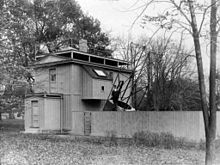Harvard College Observatory
The Harvard College Observatory ( Harvard College Observatory , HCO ) is the astronomical observatory of the Department of Astronomy of Harvard University . It is located in Cambridge , Massachusetts in the United States . Together with the Smithsonian Astrophysical Observatory , it is part of the Harvard-Smithsonian Centers for Astrophysics .
The observatory was established in 1839 at the suggestion of William Cranch Bond , who became its first director.
In 1847 a 15 inch (42.5 cm) aperture refractor was installed, which was the largest telescope in the world for the next twenty years .
Between 1847 and 1852, Bond and John Adams Whipple , a pioneer of astrophotography , used the large refractor to take detailed images of the Earth's moon . The photos won the photography prize at the World Exhibition in London's Crystal Palace in 1851 .
On the night of July 16-17, 1850, Bond and Whipple created the first daguerreotype of a star , Vega in the constellation Lyra .
Around 1906, under the then director Edward Charles Pickering, the one from Andrew Ainslie Common was acquired from his estate along with a second mirror and built in the observatory. For the next 10 years it was the world's largest telescope in scientific operation, although the optics were not entirely satisfactory. The telescope was moved to the Boyden Observatory in South Africa in 1933 as a 1.5 m UFS Boyden Rockefeller reflector . The second mirror was turned into another one at the Oak Ridge Observatory , which was, however, equipped a short time later with a 61-inch mirror made of Pyrex.
Over time, several asteroids have been discovered at the Harvard College Observatory.
Directors
- William Cranch Bond 1839-1859
- George Phillips Bond 1859-1865
- Joseph Winlock : 1866-1875
- Edward Charles Pickering 1877-1919
- Solon Irving Bailey 1919-1921
- Harlow Shapley 1921-1952
- Donald H. Menzel 1952-1953 (Acting Director); 1954–1966 (director)
- Leo Goldberg 1966-1970
- George B. Field 1971-1972
Web links
- Website HCO (English)
Coordinates: 42 ° 22 '53.5 " N , 71 ° 7' 42.1" W.


